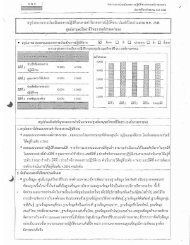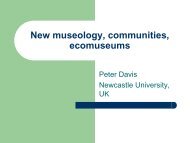Download
Download
Download
Create successful ePaper yourself
Turn your PDF publications into a flip-book with our unique Google optimized e-Paper software.
Ratchaworawiharn Temple Museum in Bangkok hadthe chance to learn about the temple’s use of ancientmanuscripts called dtam rai yaa, which describe commondiseases and provide lists of herbs that can be mixed totreat the ailment in question. The dtam rai yaa, however,do not specify the order in which the herbs should becombined or the quantities that should be used; friendsor relatives of the sick individual had to consult the monksthemselves for directions and guidance. In this way, themonks could ensure that the medicines were preparedcorrectly, and knowledge of the herbal remedies waspassed to others through demonstration and practice.The essential role of nature in coping with variouschallenges was evident across all five core ideas, including8Examples of dtam rai yaa from the NangRatchaworawiharn Temple Museum in Bangkokthe third core idea, “local knowledge versus war andpolitics.” The period of the Greater East Asia War (1942-1945) was a difficult, uncertain time for communities acrossThailand; daily life was characterized by anxiety and lackof necessities. Clothing in particular was very expensiveand hard to obtain, and many people found themselveswearing rags or even no clothing at all. Local peoplein Chacheongsao province, whose stories have beencollected by the Saay Yai Community Thai Cultural Center,looked to the environment around them and realized thatbanana tree fibers could be dried and cut into thin threads.They used this banana fiber thread in place of cotton orsilk thread to weave clothes that protected their bodiesand servedas effectivecamouflageduring potentialair raids.By mid-1943,Allied aircraftfrequentlybombed targetsin Thailand,seeking outconcentrationsof Japanesetroops. Thecity of ChiangMai became afocal point of theThe temple bell from Sri Don KhamTempleattacks, but bombs also fell in surrounding provinces.When locals in Phrae province discovered an undetonatedbomb in a field, they removed the gunpowder and usedit to catch fish by setting off small explosives in the water.The shell of the bomb was brought back to a villager’shome and filled with water for washing feet. A monk,intrigued after seeing the unusual water vessel, asked ifhe could strike it to test its sound; he found the timbreto be pleasant to his ears. The bomb shell was thusconverted into a temple bell and today is housed at SriDon Kham Temple in Phrae. This bomb-turned-basinturned-bell,aside from illustrating the inventiveness andresourcefulness of villagers in Phrae, also expressesthe many layers of meaning embedded in objects andthe vital role that local museums play in gathering andtransmitting these rich, multivalenced histories.The fourth core idea of the festival was “localknowledge versus economy.” This core idea emphasizedthe premise that the neoliberal economic systemdeprives everyday people of bargaining abilities, andthese individuals struggle to make a living. Local peoplewhose lives have been affected by development and thehighly competitive capitalist market have shared storiesthat reflect a renewed focus on cultivating a sense ofcommunity and the importance of cultural capital. InSongkhla province in 1984, an abbot from Don Temple







